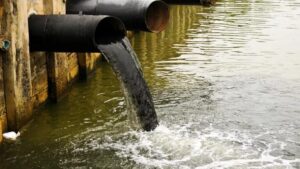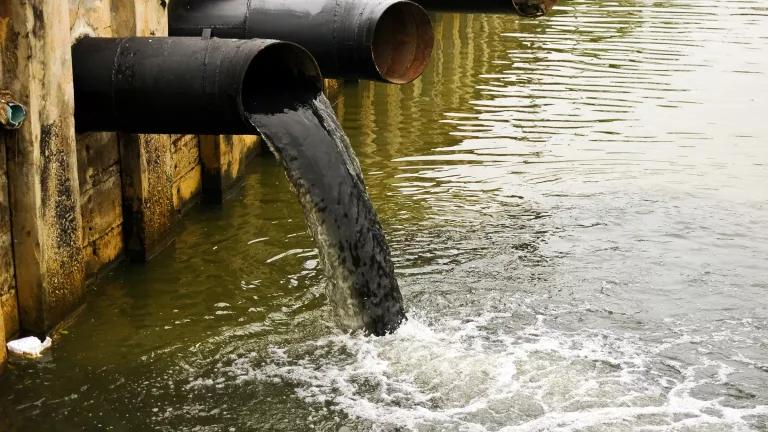Terry Conway writes for International Viewpoint

The state of the water industry has been a matter of increasing concern in British politics over recent years. More and more stories have about the excessive dumping of sewage into rivers and seas. In many local areas, especially on the coast or where rivers are significant local attractions, this despoliation has become the focus of strident local organising. This has gained support from people who have traditionally voted for the ruling Conservative Party.
The sewerage system carries rainwater and wastewater from toilets along the same pipes to the water treatment works. When there is too much rainfall, water companies are allowed to discharge overflow from these pipes into the waterways. This should happen rarely, but data – and experience – show it is happening more and more.
There are a number of different factors involved. Climate change is resulting in more dramatic weather patterns – periods of drought which lead to the ground becoming baked dry, followed by heavy thunderstorms which the land is not able to absorb. This leads to flooding and to more discharges. These phenomena have not resulted in the same level of deaths and loss of crops, homes and other resources as in Africa and Asia. But they are nevertheless still significant. And in Britain, this is compounded by the increasing proportion of land which is concreted over – and to the use of artificial rather than natural grass.
Another reason is the growth of intensive farming – in particular, factory farming of livestock. Particularly with poultry and pigs and the dairy industry, the slurry run off is a huge factor in contaminating rivers. George Monbiot, who writes for the UK newspaper The Guardian, argues that farming is the top cause of river pollution in the UK, a greater threat even than sewage pollution.
These two areas pose challenges which I don’t have the scope to further explore in this piece. I will rather focus on the impact of the privatisation of the water and sewage system, and how this has intersected with other erosions of public services, such as the cuts to the Environment Agency.
THATCHER’S PRIVATISATION DRIVE
Privatisation in general was a key theme of Margaret Thatcher’s four Conservative governments in control of the Westminster parliament between 1979 and 1990. Particularly after 1983 the ideological argument about the discipline of the market took increasing priority over the wish to make a profit for the government from the sell offs. The idea was that privatisation would make the large utilities more efficient and productive, and thus make British capitalism competitive, relative to its continental rivals.
The nationalised industries were suffering from underinvestment and were not subject to genuine democratic control. This helped them to drive through these policies with all too little opposition. To be fair, so too did the fact that there were other key battles against Thatcherism for the Left and the labour movement. In1984-85 there was a major class battle in the form of the Miners’ strike. Then came the campaign against the introduction of the poll tax – introduced in Scotland in 1989 and then in England and Wales from 1990.
There were campaigns to defend the NHS from privatisation – as well as cuts – and around the sell-off of council housing. This was a major period of deindustrialisation and attacks on trade unions, so protests around manufacturing sectors such as British Steel focused more on job losses than on the question of ownership. Within this panoply of attacks on the working class, the least concentration of all was on the privatisation of utilities – British Gas (1986), water (1989), and electricity (1990).
WATER PRIVATISATION
Water is unarguably a natural monopoly. Despite this, Thatcher’s Tories did not hesitate to sell it off for a meagre £6.1 billion. At the same time a Water Services Regulation Authority (Ofwat) was created, supposedly to regulate the companies’ behaviour. The extent to which it has even tried to do that will become an important thread in this tale.
“Regulation was flawed from the outset in that it provided no checks to financial engineering and excessive borrowing,” said Dieter Helm, professor of economics at Oxford university.
Since then the water companies have extracted £72 billion in dividends for their share holders. This is money which should have gone into the infrastructure to ensure sewage treatment works can process what we feed them, without affecting our rivers and seas.
The industry has adopted the classic private equity business model, with its key elements of high prices, low investment and financial engineering to extract high returns. Instead of shareholders making long-term investment through equity, this business model uses debt, because interest payments qualify for tax relief. In effect this is a public subsidy. This reduces the cost of capital and increases returns to shareholders, but it also increases vulnerability to interest rate hikes.
A report by Richard Murphy, Professor of accounting practice at Sheffield University, has calculated that between 2002 to 2022, the nine water and sewerage companies in England and Wales benefited from a 35% profit margin (before financing costs). They paid out £24.8bn of profits in dividends.
Meanwhile, almost 400,000 sewage dumping incidents were recorded in England and Wales in 2022, adding up to 3.3 million hours of pollution pouring into the country’s waterways. Interactive maps with figures for the whole country can be found here. And despite the population growing by nearly 10 million, no new reservoirs have been built.
In the meantime, the Environment Agency found that 90% of sewage monitors at seasides are broken. In many locations, they’re not installed at all. Over summer 2022, dozens of beaches were closed to swimmers due to the high levels of toxic waste. And there may have been many more that went untested. And less dramatically, some 2.4 billion litres of water are lost every day to leaks due to poor infrastructure. Meanwhile water charges to households have increased by 40 percent in real terms since privatisation
REVOLVING DOOR
Two thirds of England’s water companies employ key executives who previously worked for Ofwat, the watchdog that is supposed to regulate them.
An analysis by the Observer
has found 27 former Ofwat directors, managers and consultants working in the industry they helped to regulate, with about half in senior posts…Six of the nine water and sewerage companies in England have hired directors of corporate strategy or heads of regulation who previously worked at Ofwat, including former director of strategy Andrew Beaver, now at Northumbrian Water, and former director of strategy and planning Iain McGuffog, now at South West Water… The findings have raised fresh concerns over a revolving door between the regulator and the industry.
The focus on this deeply problematic relationship has ramped up further in the last couple of weeks. There have emerged concerns that Thames Water, the biggest of the companies, supplying 15 million households, is at risk of collapse from about £14bn of debts. Thames loses around 630 million litres of water a day in leaks and routinely dumps tons of raw sewage in rivers. Since 2010, it has been sanctioned 92 times for failures and has been fined £163 million. Over the last three years, the salary of its recently resigned chief executive doubled.
Thames Water’s current joint Chief Executive, Cathryn Ross, was previously head of Ofwat from 2013 – 2018. On July 11, she refused to apologise in front of a committee of MPs for her behaviour at the regulator, where she allowed the firm to rack up £14 billion of debt, while failing to curb dividends to share holders.
PROSPECTS FOR CHANGE
Public anger at all this is growing. There is more demand now for renationalisation than there was opposition to the original privatisation. But despite the depth of the crisis of the current Tory government under Rishi Sunak, it’s unlikely to be a concession he is prepared to make.
While Britain does not have to hold a general election until 2025, the expectation is that it is almost certain to take place in 2024, either in the spring or summer. Barring dramatic political about turns, this will result in the election of a Labour government. When the current leader of the Labour Party, Keir Starmer, was elected to that position in 2020, he stood on a platform of 10 pledges – of which water renationalisation was one.
Like the overwhelming majority of those other pledges, he has already reneged on it, in a rush to demonstrate what a safe pair of hands he is for British capital. There are rumours that he is contemplating backing some form of ‘social purpose’ company – keeping water in private hands but supposedly imposing more social responsibility.
The question will be whether it is possible to mount a campaign for genuine renationalisation – under greater public accountability than before.



